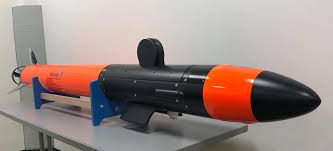UUV BAE Systems Riptide
Di recente, il braccio di ricerca e sviluppo FAST Labs ™ della BAE Systems ha annunciato l'acquisizione della società Riptide Autonomous Solutions. L'obiettivo dell'acquisizione era quello di accoppiare i veicoli sottomarini senza pilota (UUV) denominati Riptide con il sistema di missione leader del settore come:
- autonomia,
- navigazione,
- comunicazioni,
- elaborazione dei sensori,
- guerra elettronica
- e altro ancora.
La famiglia degli UUV Riptide comprende tre offerte:
- il diametro da 4.875 "(25 lbs.) Micro,
- l'unità da 7.5" (65 a 120 lbs.) Da 1 MP (portatile),
- e l'unità da 9 "(9.375") (da 120 a 240 libbre.) 2MP.
Questi piccoli veicoli senza pilota portatili sono piattaforme altamente sofisticate, semplici, efficienti e altamente flessibili che offrono discriminatori delle prestazioni tra cui la capacità di esibirsi a maggiore profondità, a lungo raggio, con maggiore resistenza e a maggiore velocità.
Il primo anno del Riptide è stato incentrato sulle pietre miliari dell'integrazione e dell'infrastruttura, tra cui:
- Il Nuovo stabilimento di produzione;
- un prototipo all’avanguardia;
- un nuovo sito di produzione a Plymouth, nel Massachusetts, che aumenta notevolmente la capacità sia per lo sviluppo dei veicoli sia per il personale incentrato sulla linea di prodotti Riptide;
- prezzi commerciali allo scopo di semplificare l'acquisizione dei veicoli impiegando configurazioni di sistema standard incentrate sulla missione che soddisfino i clienti, migliorando continuamente la qualità, l'affidabilità e la ripetibilità del veicolo;
- dimostrazioni del sistema entro pochi mesi dall'acquisizione.
L’attività dimostrativa ha unito l’autonomia avanzata e la tecnologia a radiofrequenza con la nuova piattaforma UUV recentemente acquisita, dimostrando la facilità di integrazione e la capacità di trasferire la tecnologia del dominio aereo precedentemente utilizzata in un'applicazione sottomarina.
L'architettura modulare dei sistemi aperti BAE Systems ha la comprovata capacità di integrare e mettere in campo rapidamente nuove soluzioni in un'ampia gamma di missioni.
La nuova struttura e gli ulteriori investimenti hanno consentito una serie di tappe fondamentali del prodotto, tra cui la maturazione dei primi prototipi in sistemi pronti per la produzione:
- Micro UUV - migliorato con nuove funzionalità; 1MP UUV - prototipo completato;
- 2MP UUV: design e prototipo di nuova generazione completati. La società britannica ha sviluppato il primo prototipo dell’UUV da 6000 metri: questa profondità in un piccolo UUV consentirà una flessibilità ed un'efficienza dei costi senza pari, affrontando missioni senza precedenti per la piccola classe di UUV, riducendo le barriere per accedere agli oceani profondi.
La famiglia Riptide di veicoli sottomarini autonomi offre una soluzione sostenibile e scalabile per gli sviluppatori di autonomia e comportamenti, sistemi di alimentazione, sensori sottomarini e nuovi payload.
Tra i molti usi commerciali e militari per gli UUV ed i pacchetti di sensori vi sono:
- la sorveglianza dei fondali marini,
- la protezione dei porti,
- la raccolta di informazioni,
- la sorveglianza delle infrastrutture,
- il rilevamento di petrolio e gas,
- le contromisure anti mine.
ENGLISH
Riptide UUVs making waves in the industry only one year after acquisition.
One year ago, the FAST Labs™ research and development arm of BAE Systems announced the acquisition of Riptide Autonomous Solutions. As stated at the time, the goal of the acquisition was to pair Riptide’s disruptive unmanned underwater vehicles (UUV) with our industry-leading mission system capabilities such as autonomy, navigation, communications, sensor processing, electronic warfare, and more.
The Riptide family of UUVs includes three offerings: the 4.875” diameter (25 lbs.) micro, the 7.5" diameter (65 to 120 lbs.) 1MP (man-portable) unit and the 9" (9.375”) diameter (120 to 240 lbs.) 2MP. These man-portable small unmanned vehicles are sophisticated yet simple, efficient, and highly flexible platforms that offer performance discriminators including being able to perform at greater depth, at longer range, with more endurance, and at greater speed.
Setting a course. Year-one of Riptide has been focused on integration and infrastructure milestones including the following:
- New manufacturing facility – a multi-million dollar state-of-the-art prototype and production site in Plymouth, Massachusetts, that greatly increases capacity for both vehicle development and personnel focused on the Riptide product line.
- Commercial pricing model – established to streamline vehicle acquisition by employing standard, mission-focused system configurations that satisfy our broad customer base while continually enhancing vehicle quality, reliability and repeatability.
- System demonstrations – within just a few months of the acquisition, the team demonstrated an integrated solution at the Advanced Naval Technology Exercise, or ANTX 2019. The demonstration paired our advanced autonomy and radio frequency technology with the recently acquired platform, showcasing the ease of integration and the ability to transition previously used air-domain technology into an undersea application. BAE Systems’ modular open systems architecture has the proven ability to rapidly integrate and field new solutions across a wide array of missions.
- Product advancement – the new facility and additional internal investments led to a number of product milestones including the maturing of early prototypes into production-ready systems.
- Micro UUV – enhanced with new feature functionality.
- 1MP UUV – prototype completed.
- 2MP UUV – next-generation design and prototype completed.
Additionally, we have developed the first prototype of our 6000 meter rated UUV. This depth in a small UUV will allow unparalleled flexibility and cost efficiency by taking on missions unprecedented for the small class of UUVs, reducing the barriers to access the deep ocean.
Riptide family of autonomous undersea vehicles brings a sustainable and scalable solution for developers of autonomy and behaviors, power systems, subsea sensors, and new payloads. Among the many commercial and military-based uses for the UUVs and sensor packages are seabed surveillance, harbor protection, intelligence collection, infrastructure surveillance, oil and gas survey, and mine countermeasures.
(Web, Google, Wikipedia, Navyrecognition, You Tube)
































































